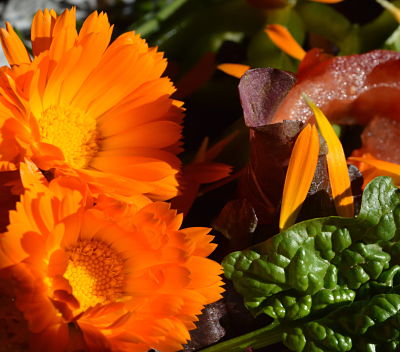 Calendula officinalis is a beautiful golden garden flower that has been used for food, medicine and skin care throughout history. Calendula provides an incredible amount of therapeutic benefits, with being most known for its skin care properties.
Calendula officinalis is a beautiful golden garden flower that has been used for food, medicine and skin care throughout history. Calendula provides an incredible amount of therapeutic benefits, with being most known for its skin care properties.
The flowers are used medicinally for the skin in the form of both oil infusions and tinctures, all easy to create yourself. In our modern lifestyle it is important to find simple and quick ways to include herbs in our lives. An incredibly easy way to reap the skin-care benefits from Calendula is to eat the petals. Calendula petals are packed with carotenoids and flavonoids, giving them their brilliant golden colors. Carotenoids and flavonoids that give plants their variety of colors, also give them protection from the damaging effects from the sun. As we include them in our diet, they are distributed in our skin, helping not only protect our skin from sun damage, but also helping repair previous damage. Although there doesn’t seem to be an association between the color of the petals and flavonoid content, research has shown an association with carotenoids. The color intensity of the orange petals is primarily due to lycopene, which is absent in the yellow colored petals. Both yellow and orange varieties were shown to contain beta-carotene. Our skin is enriched with beta-carotene and lycopene, both found in the orange varieties of Calendula. The amount of carotenoids increases with color intensity.
Both the photoprotective and photo-aging protective benefits to the skin depends on both the dose and length of time beta-carotene is consumed. It has been shown that it takes several weeks with 30 mg of consuming beta-carotene to benefit the skin, with an improvement in facial wrinkles and elasticity in 90 days. Eating a variety of different colored fruits and vegetables (and a few flowers) is a great way to help protect and improve the quality of our skin. 
The golden petals are especially pretty sprinkled over soups and salads, as well as added to rice, egg, and potato dishes. Using Calendula flowers is a fun and beautiful way to increase carotenoids and flavonoids in our diet.
Calendula Safety
Although Calendula has been shown to be very safe, those who are pregnant are advised not to use Calendula orally or topically. Calandula can also cause allergies with some people who are sensitive to the Asteraceae family, such as ragweed, chrysanthemums, marigolds, and daisies.
References:
Stahl, W., Sies, H. (2007). Carotenoids and flavonoids contribute to nutritional protection against skin damage from sunlight. Molecular Biotechnology, 37(1):26-30.
Schagen, S.K., Zampeli, V.A., Makrantonkai, E., Zouboulis, C.C. (2012). Discovering the link between nutrition and skin aging. Dermato-Endocrinology, 4(3):298-307.
Sausserde, R., Kampuss, K. (2014). Composition of carotenoids in Calendula (Calendula Officinalis L.) flowers. Foodbalt, Institute of Agrobiotechnology.
Raal, A., Kirsipuu, K. (2011). Total flavonoid content in varieties of Calendula officinalis L. originating from different countries and cultivated in Estonia. Natural Products Research, 25(6):658-662.
Cho, S., Lee, D.H., Won, C.H., Kim, S.M., Lee, S., Lee, M.J., Chung, J.H. (2010)Differential effects of low-dose and high-dose beta-carotene supplementation on the signs of photoaging and type I procollagen gene expression in human skin in vivo. Dermotalogy, 221(2):160-71.
